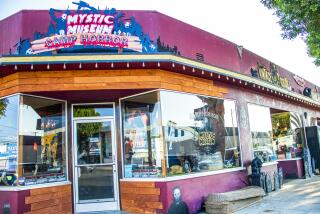Morbidity Museum a Macabre Showplace
- Share via
BANGKOK, Thailand — It’s a rare museum where visitors are welcomed by the founder’s skeleton.
But the father of Bangkok’s Forensic Museum donated his body to his life’s cause, and his bones now rest at the entrance for medical students and ordinary onlookers to examine.
This macabre monument to death and its causes attracts more visitors -- often 100-plus a day -- than any art gallery and many other museums in Thailand’s capital. They range from those with a morbid curiosity to serious students of medicine and forensic science.
Visitors can study hemorrhaged brains, severed arms with tattoos and lungs with stab wounds. One case holds skulls punctured by bullet holes, shot at from different angles by forensic scientists in an experiment to study how bullets ricochet inside a human head. Results help them analyze evidence in murder cases.
By far the most popular display is the mummified body of Si Ouey, a notorious cannibal and serial killer of boys and girls in the late 1950s.
“Don’t commit a crime, otherwise you will end up like this,” says Dr. Somboon Thamtakerngkit, museum curator and chief of forensic pathology at Siriraj Hospital, where the museum is located.
Somboon says Thai mothers used to scare naughty children with tales of Si Ouey, who was finally caught when the father of one victim and a policeman discovered him at home about to eat the child’s organs.
“Si Ouey thought that it was healthy to eat fresh livers and hearts,” Somboon says.
The killer’s body -- shriveled, brown and coated in wax to prevent mold -- slumps against the glass of a phone-booth-like case. A close look reveals incisions in his head made by Thai pathologists who examined his brain for any abnormalities that might mark a serial killer.
Many of the displays teach about the body and what can go wrong with it.
“We respect the bodies as if they were our teachers or professors. Without them, we wouldn’t be able to learn,” Somboon says, adding that many Thais have donated their bodies.
One set of blackened lungs may give pause to smokers. An aorta with calcium deposits shows how heart attacks result from clogged arteries. One heart is twice the normal size from hypertension.
Reactions range from scientific curiosity about the human body to grimaces of revulsion and from giggles to quiet respect for the dead. Some leave candies or toys near the bodies of babies preserved in formaldehyde.
One baby boy is displayed as an example of hydrocephalus, a condition in which the head becomes too large for the body to support.
“We asked the parents: ‘Can we keep the body? Then if you miss him, you can come and see him.’ They said OK, and so we have him,” Somboon says.
One visitor, Pearl Tay, stands near a photo of a woman who was choked to death and notes that dropping by after lunch might not be the best idea.
Her friend, Victor Chia, a biology buff from Singapore, finds the museum extraordinary. “It’s not available in our own country. It’s very definitely not what you see in other museums.”
At the exit door, offering visitors a silent goodbye, is the skeleton of Songkran Niyomsane, the father of forensic medicine in Thailand and the museum’s founder. He died in 1970.
More to Read
Sign up for The Wild
We’ll help you find the best places to hike, bike and run, as well as the perfect silent spots for meditation and yoga.
You may occasionally receive promotional content from the Los Angeles Times.






